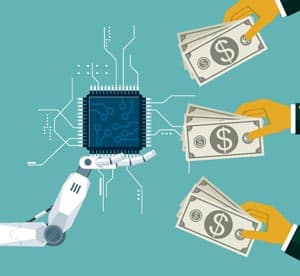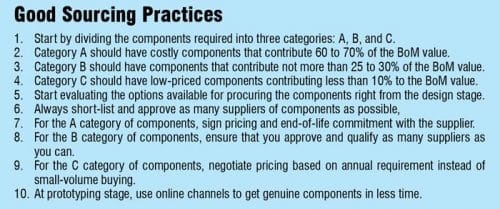 When should a start-up start planning sourcing of the components for their products, and how can they ensure that they get the components that they need on a regular basis, without any break, and at the right price? These are some of the things that are important for any manufacturer, but more so for a new start-up or MSME
When should a start-up start planning sourcing of the components for their products, and how can they ensure that they get the components that they need on a regular basis, without any break, and at the right price? These are some of the things that are important for any manufacturer, but more so for a new start-up or MSME
Raising funds is one of the toughest tasks for a start-up today. Be it a software, services, or a hardware start-up, the grind is almost similar for each. However, there is an additional challenge that a hardware start-up has to address, unlike any other. It is related to making a choice between the set of components available in the market.
“Components contribute 40% towards the bill of materials (BoM) of any electronic product or system. If we take out the PCB and electro-mechanical parts from the 40% BoM cost, then the semiconductors, passives, connectors, and the display contribute around 30% to the cost. The big companies manufacturing consumer electronics and mobile phones usually import completely knocked down (CKD) kits. None of the mobile phones are designed in India. Component sourcing, for these big companies, is not a big challenge,” says Sanjeev Keskar, CEO, Arvind Consultancy.
He adds, “But a lot of big distributors find it challenging to work with start-ups owing to the minimum order quantity targets. Also, if you look at the global components industry, you will find that it is a cyclic industry. Sometimes it has surplus capacity and sometimes it faces shortage of components. The big companies always get priority from component makers and suppliers.”
Many pieces: Same puzzle
A big challenge that a lot of start-ups and MSMEs face is in sourcing the set of components that complement each other. There are sensors, resistors, capacitors, connectors, microcontrollers, FPGAs, MOSFETs, transistors, diodes, and more.
“If you get 98 components out of the required 100, you cannot get your product manufactured. That, I think is the biggest problem that most of the start-ups and MSMEs are facing,” explains Keskar.
Another piece of the puzzle revolves around the pricing of the components or the kits of components available in the market. The challenge also includes the credit facilities that are generally not available for start-ups and MSMEs.
“Start-ups and MSMEs have to pay in advance to procure the components and, often, the supplier delivers only 92 components (as an example) out of the100 required and pushes the date forward by one or two months for the remaining components. This loss of time results in skyrocketing of inventory holding costs for a start-up or an MSME,” explains Keskar.
Another challenge faced by a lot of start-ups and MSMEs is the ‘just in time’ need of the inventory. It is a known fact that India depends on imports of components from countries like China and Taiwan. The lead time for a component is generally 30 to 45 days.
“The lead time of 30 to 45 days when added with the time taken for customs clearance, and the price of maintaining the inventory for all these days, can create a huge disability for start-ups and MSMEs in electronics hardware. The inventory maintenance costs, freight costs, and the cost of finance add a disability of eight to ten percent for start-ups and MSMEs in India,” says Keskar.
He adds, “On one hand start-ups and MSMEs are facing a disability of eight to ten percent and on the other they are competing against global brands. In the end market, these start-ups and MSMEs have to be competitive in the pricing part as well.”
Though some respite for some of these challenges is offered by the online market and local traders sitting in places like New Delhi’s Nehru Place market, the costs involved in such solutions is a big challenge on its own.
“There are local dealers selling components that have outdated in international markets. Of course, these come cheap, but the validity of your product based on such components will be next to nothing when they hit the market,” advises Keskar.
However, going with the authorised distributors usually means paying more than what a start-up or MSME will have to pay to an online channel.
The solution
The solution to most of the problems stated above lies in dividing the bill of materials (BoM) into three parts: A, B, and C. Here, the A category of components generally include the costly components like FPGAs, microprocessors, and microcontrollers that make up for 60 to 70% of the total bill of materials cost. The B category of components could include sensors, MOSFETs, memory chips, etc. This category, as Keskar explains, usually contributes 20 to 30% of the BoM value. The C category components like resistors, capacitors, inductors, and connectors usually contribute 10% or lesser to the BoM value.
 “When planning to source A category components, start-ups and MSMEs must be very very particular. They must know that a lot of software and design efforts go into A category of components. The success of your company depends a lot on how you select the A category of components,” explains Keskar.
“When planning to source A category components, start-ups and MSMEs must be very very particular. They must know that a lot of software and design efforts go into A category of components. The success of your company depends a lot on how you select the A category of components,” explains Keskar.
He adds, “This is because once you design using A category of components, with a lot of effort in the hardware, software, and other stacks, you lose on the negotiation power completely. The supplier knows you are ‘locked’ as changing the specs after a year of efforts is almost impossible.”
Hence, it is better to start negotiations with the supplier when you are still designing the product.
“Even the distributors will support you at the time of designing because they know that they have competition, and you can easily replace them at the drop of a hat. I think this is the most critical step for any start-up or MSME to source components effectively. Evaluate all the possible solutions when choosing the A category of components. These evaluations should be done both technically as well as commercially,” notes Keskar.
He adds, “Negotiate very hard because you are going to give them a socket. Let’s say that in terms of controllers there are five options, evaluate every single of them. Apart from checking them on the technical and commercial level, make sure you also know how good the after-sales technical support is. What if you choose a $1 component over a $1.15 component but the technical support offered with the same is not up to the mark?”
While choosing A category components, another important aspect which the start-ups and MSMEs must check is that the manufacturer or the supplier does not have any immediate ‘end of life’ plan for the same.
“All your efforts will go waste, if such a thing happens! When you are selecting any A category component, make sure you have a commitment of at least five years from the manufacturer or the supplier. It is also good to sign a pricing contract along with this commitment,” explains Keskar.
Coming to the B category of components, it is important to note that most of these are usually multi-sourced parts, parts that are compatible pin-to-pin. Keeping options that cover four to six suppliers of B category components can be a very good start. However, a start-up needs to qualify all the suppliers’ list.
“What if one supplier goes into shortage, you should always have an alternate. This is why you should approve and qualify all the suppliers providing B category components. Always remember that the B category of components contribute around 25% of the BoM value,” says Keskar.
Another advantage of approving all the suppliers comes in the form of negotiation power it empowers you with. If the suppliers know that you already have other suppliers waiting to supply you the components, they will do everything possible to add your start-up into their list of regular clients.
“When you are ready to place the final order, you can really negotiate with the vendors and finalise with the one ready to supply these at the least prices and provide maximum support,” explains Keskar.
There are also multiple suppliers ready to provide the C category of components in India. Tricks that work for the C category of components include annual buying. Start-ups and MSMEs need to remember that the financial impact here is not that big as the C category usually contributes around 10% or lesser of the total BoM value.
“Here you should try to go for annual volumes instead of small volumes. Big volumes always help negotiate better because you are buying big and helping the supplier clear his storage houses and make way for new batches,” explains Keskar.
Keskar advises that start-ups and MSMEs should look towards online channels for sourcing components at this stage as an online channel is the fastest medium for sourcing components within seven to ten working days.
“Start-ups and MSMEs may end up paying higher prices but then this method is the finest and fastest way to meet any type of critical requirements. This channel also ensures that you get genuine components,” explains Keskar.
“Component sourcing is not rocket science. The only thing that matters is how well you plan your component sourcing needs. The key is not to be dependent on one supplier only,” adds Keskar.







